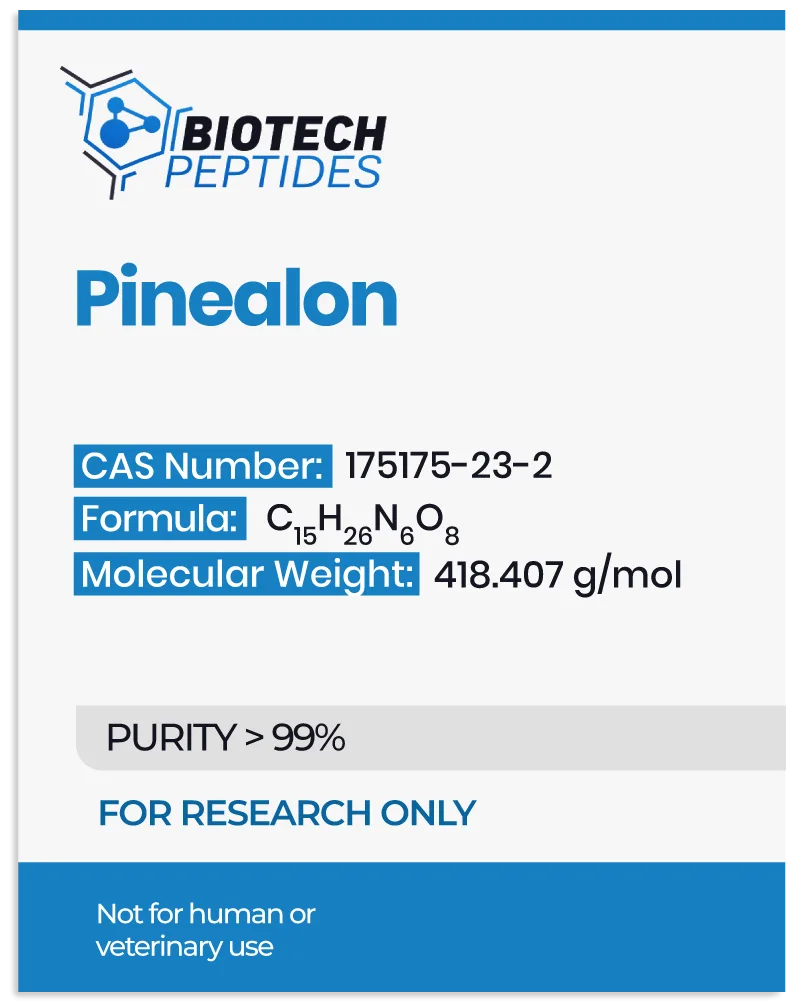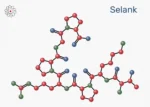Research has associated Pinealon with a range of impacts on cellular processes, particularly behavior modulation, and has suggested its role in cellular protection under hypoxic (low oxygen) conditions. Given its possible influence on the pineal gland, Pinealon has drawn scientific interest for its potential impact on physiological processes involving compound metabolism, circadian rhythm regulation, memory retention, and cognitive functions.
Mechanisms of Action
Pinealon peptide appears to exhibit a distinctive mechanism of action compared to other peptides. Unlike most peptides that rely on surface or cytoplasmic receptor interactions, Pinealon appears to bypass these conventional pathways. Due to its small molecular size, Pinealon peptide is believed to penetrate lipid bilayers, enabling it to cross both cellular and nuclear membranes and gain direct access to DNA.
Experimental studies[2], including research on HeLa cell models, suggest that Pinealon’s potential to permeate cellular barriers permits direct engagement with nuclear DNA. This direct DNA interaction indicates that Pinealon may function as a modulator of gene expression, a feature that might underlie its broad impacts independent of typical receptor-mediated pathways.
Scientific and Research Studies
Pinealon Peptide and Circadian Rhythm Modulation
Pinealon peptide has been observed in early research to play a potential role in modulating the sleep-wake cycle and associated physiological behaviors. Findings indicate that Pinealon may help counteract dysfunctions induced by circadian disruptions. This peptide has appeared promising to researchers studying possible re-establishing baseline function of the pineal gland during circadian rhythm disturbances, potentially enhancing sleep quality, behavioral stability, blood pressure regulation, and associated physiological parameters.
According to researchers[3], the research implication of bio-regulating peptides “was found to restore the organism’s adaptive potential, [better-supported] psychoemotional indices, intensified resistance to work stress and reduced occupational risk of borderline [cognitive] disorders.” The connection between sleep regulation and cellular aging processes has been well-documented in scientific studies, with disrupted sleep patterns thought to possibly affect cognitive function, cardiovascular function, wound recovery, and other areas, collectively accelerating cellular aging.
Pinealon’s capacity to potentially mitigate sleep disturbances may offer a promising approach to attenuate the cellular age-related impacts of poor sleep.
Pinealon Peptide and Regulation of Caspase-3 to Mitigate Cellular Apoptosis
Preliminary studies on Pinealon’s potential cellular impacts, particularly in ischemic stroke models in rats, suggest it may influence key cytokine signaling pathways that regulate caspase-3 enzyme levels. Caspase-3 is integral in triggering apoptosis, the programmed process of cell death. By modulating caspase-3 activity, Pinealon peptide may disrupt the progression of apoptosis, potentially reducing cell damage under conditions of oxygen deprivation, as observed in stroke-related cellular stress.
The role of caspase-3 extends beyond neural tissue and is present across various cell types. Studies using myocardial infarction models indicate that Pinealon peptide may reduce caspase-3 expression after a cardiac event, hinting at its potential to attenuate cellular apoptosis linked to post-myocardial infarction tissue remodeling.[4]
Furthermore, studies on dermal cells suggest Pinealon’s said ability to downregulate caspase-3 expression, where it appears to decrease apoptosis and support cell proliferation. This reduction in apoptotic activity may support better-supported regenerative processes, promoting cellular resilience and repair in diverse tissue types.[5]
Pinealon Peptide and Neuroprotective Mechanisms
Research in prenatal rat models suggests that Pinealon peptide may offer neuroprotection by reducing oxidative stress, potentially supporting cognitive function and motor coordination. Studies report a marked decrease in reactive oxygen species (ROS) accumulation and necrotic cell count within the brain, implying that Pinealon may protect neurons from cell death.
Additionally, Pinealon’s observed impacts on ROS reduction and necrotic cell mitigation suggest that it may interact with the cell genome directly. Specifically, research indicates that “Pinealon is able to interact directly with the cell genome,” highlighting that while lower concentrations of Pinealon may primarily restrict ROS accumulation and cell mortality, higher concentrations appear to modulate the cell cycle directly.[6]
Data further indicates that Pinealon peptide may promote cell cycle modulation by activating pathways associated with cellular proliferation. In oxidative stress conditions, this modulation does not necessarily increase cell count but may counteract some adverse impacts of ROS. Follow-up studies in adult rat models under hypoxic conditions further support the neuroprotective potential of Pinealon. This impact is thought to result from the activation of innate antioxidant systems and suppression of excitotoxicity linked to N-methyl-D-aspartate (NMDA), which has been associated with neuronal damage in cases of traumatic brain injury, ischemic stroke, and neurotoxicity from over-activation, such as in alcohol withdrawal contexts.[7]
Moreover, Pinealon peptide has been linked to elevated levels of irisin, a peptide involved in neural differentiation, cell proliferation, and energy management within the brain. Irisin, traditionally associated with muscular tissue protection, has been recently detected in the brain, where it appears to influence gene expression in the hippocampus.[8]
Further studies in brain cortex cell cultures have suggested that Pinealon peptide may support the expression of 5-tryptophan hydroxylase through epigenetic changes. This enzyme, crucial for serotonin synthesis and release, may underlie Pinealon’s potential neuroprotective and geroprotective potential.[9]
Pinealon Peptide and Neuroprotective Anti-Cellular Aging Potential
Pinealon peptide is hypothesized to possess neuroprotective anti-aging properties within the central nervous system. Research originating in Russia suggests that Pinealon, along with the peptide Vesugen, may exhibit anabolic impacts in neural tissue, potentially slowing biological markers of cellular aging within the brain.[10]
Beyond its impact on neural cells, Pinealon peptide appears to influence a range of cellular processes. Studies indicate that Pinealon may affect muscle cell function by modulating the expression of irisin, a peptide linked to cellular resilience during physical exertion, fat oxidation, and telomere maintenance. By supporting irisin stability, Pinealon may indirectly protect telomere length, a critical factor in cellular aging and oxidative stress resistance.
Plasma irisin levels, which are thought to be associated with telomere length in functional adults, are positively impacted by calorie restriction. In fact, restriction of calorie intake is one of the few actions for which researchers have documented impacts for the extension of cellular longevity and overall biological function. Emerging data[11] also suggests that irisin may function beyond the context of muscle cells. This finding indicates that Pinealon’s potential anti-aging impacts may have widespread action. Some of these may potentially extend to brain function.
Pinealon Peptide and Impacts on Prenatal Hyperhomocysteinemia
Hyperhomocysteinemia, a condition characterized by elevated levels of the amino acid homocysteine (HC) in the bloodstream, is often indicative of severe vitamin deficiencies and has been linked to an increased risk of neurological decline. A recent study[12] aimed at investigating the potential impacts of Pinealon peptide in experimentally induced hyperhomocysteinemia in pregnant murine models. In this study, methionine was introduced to female murine models beginning in their second trimester, leading to elevated HC concentrations. Researchers then evaluated the offspring from both control and experimental groups.
Findings like these have suggested that, while Pinealon peptide did not appear to reduce or mitigate elevated homocysteine levels in the offspring, there did appear to be observable evidence of better-supported cognitive performance in the experimental group. Researchers concluded that, although Pinealon may not directly influence homocysteine metabolism, it might reduce the compound’s toxic impacts, offering a possible avenue for protecting cognitive function in conditions associated with hyperhomocysteinemia.
Disclaimer: The products mentioned are not intended for human or animal consumption. Research chemicals are intended solely for laboratory experimentation and/or in-vitro testing. Bodily introduction of any sort is strictly prohibited by law. All purchases are limited to licensed researchers and/or qualified professionals. All information shared in this article is for educational purposes only.
References:
- National Center for Biotechnology Information (2024). PubChem Compound Summary for CID 10273502, Pinealon Peptide. https://pubchem.ncbi.nlm.nih.gov/compound/Pinealon.
- Fedoreyeva LI, Kireev II, Khavinson VKh, Vanyushin BF. Penetration of short fluorescence-labeled peptides into the nucleus in HeLa cells and in vitro specific interaction of the peptides with deoxyribooligonucleotides and DNA. Biochemistry (Mosc). 2011 Nov;76(11):1210-9. doi: 10.1134/S0006297911110022. PMID: 22117547. https://pubmed.ncbi.nlm.nih.gov/22117547/
- Bashkireva AS, Artamonova VG. [The peptide correction of neurotic disorders among professional truck drivers]. Adv Gerontol. 2012;25(4):718-28. Russian. PMID: 23734521. https://pubmed.ncbi.nlm.nih.gov/23734521/
- Zhang J, Zhang W. Can irisin be a linker between physical activity and brain function? Biomol Concepts. 2016 Aug 1;7(4):253-8. doi: 10.1515/bmc-2016-0012. PMID: 27356237. https://pubmed.ncbi.nlm.nih.gov/27356237/
- Khavinson, V.K., Lin’kova, N.S., Tarnovskaya, S.I. et al. Short Peptides Stimulate Serotonin Expression in Cells of Brain Cortex. Bull Exp Biol Med 157, 77–80 (2014). https://doi.org/10.1007/s10517-014-2496-y
- Khavinson V, Ribakova Y, Kulebiakin K, Vladychenskaya E, Kozina L, Arutjunyan A, Boldyrev A. Pinealon peptide increases cell viability by suppression of free radical levels and activating proliferative processes. Rejuvenation Res. 2011 Oct;14(5):535-41. doi: 10.1089/rej.2011.1172. Epub 2011 Oct 6. PMID: 21978084. https://pubmed.ncbi.nlm.nih.gov/21978084/
- Kozina LS. [Investigation of anti-hypoxic properties of short peptides]. Adv Gerontol. 2008;21(1):61-7. Russian. PMID: 18546825. https://pubmed.ncbi.nlm.nih.gov/18546825/
- Zhang J, Zhang W. Can irisin be a linker between physical activity and brain function? Biomol Concepts. 2016 Aug 1;7(4):253-8. doi: 10.1515/bmc-2016-0012. PMID: 27356237. https://pubmed.ncbi.nlm.nih.gov/27356237/
- Khavinson, V.K., Lin’kova, N.S., Tarnovskaya, S.I. et al. Short Peptides Stimulate Serotonin Expression in Cells of Brain Cortex. Bull Exp Biol Med 157, 77–80 (2014). https://doi.org/10.1007/s10517-014-2496-y
- Meshchaninov VN, Tkachenko EL, Zharkov SV, Gavrilov IV, Katyreva IuE. [Effect Of Synthetic Peptides On Aging Of Patients With Chronic Polymorbidity And Organic Brain Syndrome Of The Central Nervous System In Remission]. Adv Gerontol. 2015;28(1):62-7. Russian. PMID: 26390612. https://pubmed.ncbi.nlm.nih.gov/26390612/
- Khavinson VKh, Kuznik BI, Tarnovskaya SI, Lin’kova NS. Short Peptides and Telomere Length Regulator Hormone Irisin. Bull Exp Biol Med. 2016 Jan;160(3):347-9. doi: 10.1007/s10517-016-3167-y. Epub 2016 Jan 8. PMID: 26742748. https://pubmed.ncbi.nlm.nih.gov/26742748/
- Arutjunyan A, Kozina L, Stvolinskiy S, Bulygina Y, Mashkina A, Khavinson V. Pinealon peptide protects the rat offspring from prenatal hyperhomocysteinemia. Int J Clin Exp Med. 2012;5(2):179-85. Epub 2012 Apr 6. PMID: 22567179; PMCID: PMC3342713. https://pmc.ncbi.nlm.nih.gov/articles/PMC3342713/







